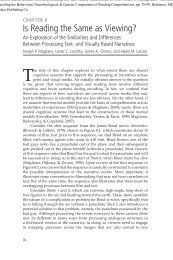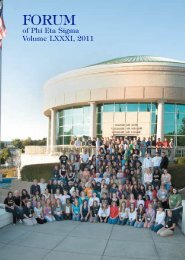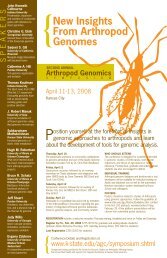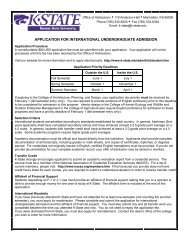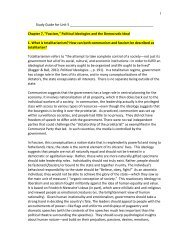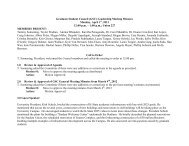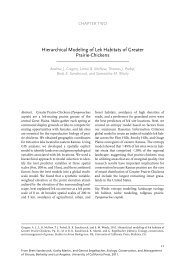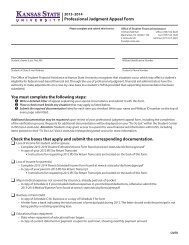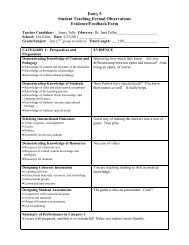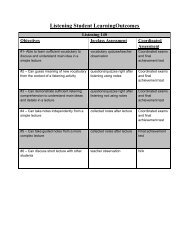Estimation of Demographic Parameters from Live ... - BioOne
Estimation of Demographic Parameters from Live ... - BioOne
Estimation of Demographic Parameters from Live ... - BioOne
Create successful ePaper yourself
Turn your PDF publications into a flip-book with our unique Google optimized e-Paper software.
sampling designs may require additional effort to ensure an<br />
adequate number <strong>of</strong> encounters within each secondary<br />
period. A second problem is that marking schemes for<br />
some wildlife species may violate the assumptions <strong>of</strong> the<br />
robust design. If estimation <strong>of</strong> survival rates is primarily<br />
based upon dead-recovery information, investigators may<br />
actively avoid recaptures <strong>of</strong> previously marked individuals to<br />
ensure that the number <strong>of</strong> newly marked individuals released<br />
each year is maximized. In a study <strong>of</strong> arctic-nesting snow<br />
geese, such a sampling design prevented use <strong>of</strong> robust design<br />
models for estimation <strong>of</strong> breeding propensity (Cooch et al.<br />
2001).<br />
New hybrid models have combined robust design<br />
methods with other approaches, including the transient<br />
(Hines et al. 2003), reverse-time (Ramsey 2005), multistrata<br />
(Kendall et al. 2003), and joint information models<br />
(Barker et al. 2004). Nott and DeSante (2002) applied the<br />
robust design-transient model to mark–recapture data <strong>from</strong><br />
breeding songbirds and obtained estimates <strong>of</strong> apparent<br />
survival that had greater precision compared to estimates<br />
<strong>from</strong> a transient-only model (DCV(^/) ¼ 1.3–29.3%, n ¼ 8<br />
spp.). Last, Ramsey (2005) used a combined robust designreverse-time<br />
model to successfully separate the contributions<br />
<strong>of</strong> fecundity, immigration, and survival to population<br />
growth rates for 3 age classes <strong>of</strong> brushtail possums<br />
(Trichosurus vulpecula).<br />
Multi-Strata Models<br />
Multi-strata (or multi-state) models are similar to CJS<br />
models in that investigators do not subdivide primary<br />
sampling occasions into shorter secondary periods. They<br />
differ <strong>from</strong> CJS models because they permit inclusion <strong>of</strong><br />
categorical data or ‘strata’ in the encounter histories that can<br />
change during the life span <strong>of</strong> an individual (Brownie et al.<br />
1993, Lebreton and Pradel 2002). For a multi-strata model,<br />
an encounter history could be coded as A ¼ site A and B ¼<br />
site B, instead <strong>of</strong> 1 ¼ detected as in the CJS models (Fig. 1).<br />
As in CJS models, 0 ¼ not encountered. The main<br />
advantage <strong>of</strong> multi-strata models is that they yield estimates<br />
<strong>of</strong> apparent survival (/ A t and / B t ) and encounter rates (pA t<br />
and p B t ) that are specific to each categorical state. Multistrata<br />
models also yield estimates <strong>of</strong> the probabilities <strong>of</strong><br />
changing states, such as movement rates <strong>of</strong> individuals <strong>from</strong><br />
site A to site B (w A B<br />
t ) or in the opposite direction (w B A<br />
t ).<br />
In the standard Arnason-Schwarz (or first-order Markovian)<br />
multi-strata model, the separation <strong>of</strong> apparent survival<br />
into strata-specific estimates (r) <strong>of</strong> apparent survival and<br />
movement (/ t ¼ / r t wr t ) requires that 2 assumptions are met:<br />
apparent survival in the interval between time i to i þ 1 does<br />
not depend on the stratum at time i 1, and all individuals<br />
make the transition at the end <strong>of</strong> the interval (Brownie et al.<br />
1993). Two additional assumptions are that observers<br />
correctly assign individuals to strata on each occasion, and<br />
that no individuals temporarily emigrate to strata where<br />
encounters do not occur (Kendall 2004). These 4 assumptions<br />
can be relaxed in memory (or higher-order Markovian)<br />
models that model transition probabilities as a function <strong>of</strong><br />
strata occupied on previous occasions (Hestbeck et al. 1991,<br />
Brownie et al. 1993), in cases where the distribution <strong>of</strong><br />
transition times is known (Joe and Pollock 2002), and in<br />
modified models that account for uncertainty or include<br />
temporary emigrants as an unobservable state (see below).<br />
One use <strong>of</strong> multi-strata models has been to test hypotheses<br />
about apparent survival and movements where breeding<br />
populations are subdivided into discrete geographic sites due<br />
to nesting on islands (Spendelow et al. 1995, Cam et al.<br />
2004), colonial breeding (Lindberg et al. 1998, Brown et al.<br />
2003, Grosbois and Tavecchia 2003, Drake and Alisauskas<br />
2004, Serrano et al. 2005), or habitat fragmentation (Lens et<br />
al. 2002, Senar et al. 2002, Barbraud et al. 2003).<br />
Investigators also have applied multi-strata models in<br />
situations where the habitat is subdivided but patches are<br />
contiguous (Hestbeck et al. 1991, Murphy 2001, Béchet et<br />
al. 2003, Pettorelli et al. 2003, Auckland et al. 2004). These<br />
studies have shown that / and w can be affected by spatial<br />
variation in size and proximity <strong>of</strong> colonies (Spendelow et al.<br />
1995, Lens et al. 2002, Brown et al. 2003, Serrano et al.<br />
2005), habitat quality (Senar et al. 2002, Pettorelli et al.<br />
2003), and hunting activity (Béchet et al. 2003), as well as<br />
temporal variation in resource abundance (Auckland et al.<br />
2004) and climatic conditions (Hestbeck et al. 1991).<br />
Grosbois and Tavecchia (2003) extended standard multistrata<br />
models by partitioning the transition rates (e.g.,<br />
w A B<br />
t ) into a 2-stage process <strong>of</strong> movement: the probability<br />
that an individual departs <strong>from</strong> one site (p A t ), and the<br />
probability that the individual then settles into a different<br />
site (l A<br />
t<br />
B ). The pl parameterization requires minor<br />
modification <strong>of</strong> the encounter histories and currently is<br />
limited to situations with up to 3 sites but will likely provide<br />
additional insights into animal movements. Multi-strata<br />
models based on spatial information are particularly useful<br />
because estimates <strong>of</strong> movement rates can be used to<br />
parameterize spatially implicit metapopulation models for<br />
modeling the dynamics <strong>of</strong> subdivided populations.<br />
Investigators also have used multi-strata models to<br />
investigate the effects <strong>of</strong> social status (Cam et al. 1998,<br />
Sandercock et al. 2000, Sc<strong>of</strong>ield et al. 2001, McGowan et al.<br />
2003, Barbraud and Weimerskirch 2005) and age on<br />
demographic rates (Wood et al. 1998, Cam and Monnat<br />
2000, C<strong>of</strong>fman et al. 2001, Blums et al. 2003, Ozgul et al.<br />
2004, Cam et al. 2005). In these situations, encounter<br />
histories are coded by social status (B ¼ breeder, N ¼<br />
nonbreeder) or by age class ( J ¼ Juvenile, A ¼ Adult), and 0<br />
¼ not detected. The 2 rates / and p are estimated separately<br />
for each demographic group, and the transition rate w<br />
becomes an estimate <strong>of</strong> the probability <strong>of</strong> changing social<br />
status or the probability <strong>of</strong> maturation. If experience or age<br />
are ordinal variables that progress during maturation, then<br />
the probability <strong>of</strong> regression to inexperienced or younger<br />
strata is usually fixed to zero.<br />
Multi-strata models based on social status for greenrumped<br />
parrotlets and 3 species <strong>of</strong> seabirds found that<br />
breeders had higher apparent survival, were more likely to<br />
remain breeders, and had higher encounter rates than<br />
Sandercock Mark–Recapture Analyses <strong>of</strong> <strong>Live</strong>-Encounter Data 1511



